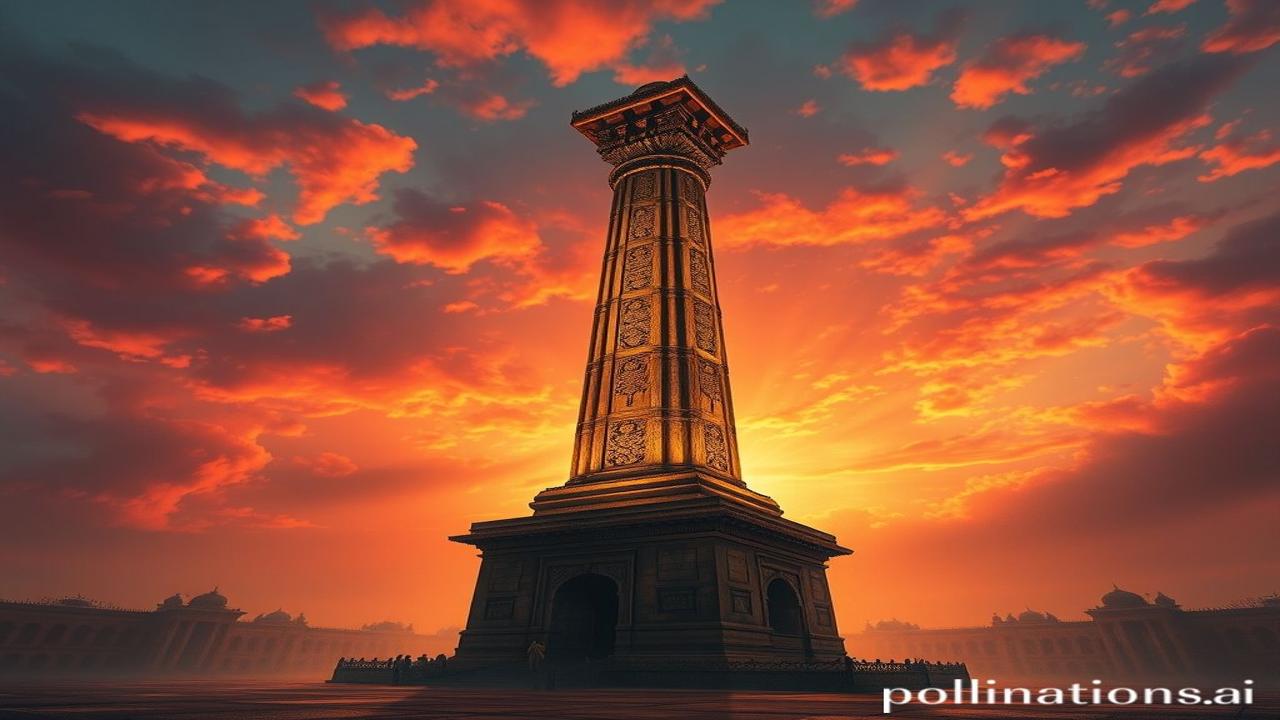Delhi Ka Lauh Stambh: Ek Rust-Proof Rahasya
Kabhi socha hai, Dilli ki dhadkan mein kitne raaz dafan hain? Imagine, ek itihas ka patthar, ek lohe ka tukda, hazaron saalon se khada hai, bina jangga lage. Yes, you heard it right. Dilli mein ek aisa stambh hai jo aaj bhi duniya ko hairan karta hai – The Iron Pillar of Delhi. Yeh sirf ek stambh nahi hai; yeh Bharat ki dhaatu-kala ka pratik hai, ek anokha rahasya hai jo waqt ke panno mein likha gaya hai. Aao, iski kahani mein doobein!
Itihas Ki Gavaahi: Lauh Stambh Kya Hai?
The Iron Pillar, yaani lauh stambh, ek 7-meter uncha lohe ka structure hai jo Dilli mein Qutub Minar ke complex mein khada hai. Iska vajan 6 tonnes se zyada hai! It’s not just any iron; it’s a testament to ancient Indian metallurgy. Isko Gupta Dynasty ke samay, around 4th century CE mein banaya gaya tha. माना जाता है कि चंद्रगुप्त द्वितीय (Chandragupta II), jinko Vikramaditya bhi kehte the, ne isko banwaya tha. Is stambh par ek inscription hai jo unke achievements ko celebrate karta hai.
Lekin, sabse badi baat yeh hai: it’s practically rust-proof! Socho, kitne saal guzar gaye, monsoon ki baarish, Dilli ki garmi, sab kuch seh kar bhi, is stambh par jang nahi lagi. Scientists aaj bhi isko study kar rahe hain, trying to unlock the secrets of ancient Indian steelmaking.
ज़मीनी सच – Raja, Kisaan, Aur Kalakaar
Picture this: 4th century CE. Raja Vikramaditya apni praja ke liye kuch anokha banana chahte hain. Unhone apne sabse mahir dhaatu-kalakaron ko bulaya.
“Humein aisa stambh banana hai jo waqt ke saath bhi khada rahe, ek pratik hamari shakti ka,” raja ne kaha.
Ek kalakaar, Somnath, ne kaha, “Maharaj, hum aisa loha banayenge jo kabhi na jhuke, kabhi na tute.”
Ma Rukmini ne aaj naye kapde pehne, kyunki mandir mein utsav tha. Aur kisaan apni fasal ke liye prarthana kar rahe the. Har koi raja ke naye nirmaan ke liye excited tha.
Un kalakaron ne kayi saal tak mehnat ki. They mixed different ores, used ancient techniques to forge the iron, and created something truly remarkable. Yeh stambh sirf lohe ka nahi tha; yeh unke skill, dedication, aur vishwas ka pratik tha.
Dharohar Aur Pehchaan: Aaj Bhi Hamare Dil Mein
The Iron Pillar aaj bhi humare liye ek yaad dilata hai ki hum kitne talented the, kitne advanced the. It reminds us of Bharat’s golden age, when art, science, and culture flourished.
Aaj, hum ise apni rituals, art, architecture, aur festivals mein dekhte hain. The spirit of innovation, the dedication to craftsmanship, yeh sab kuch hamari Bharatiya identity ka hissa hai. Think about it: hum aaj bhi is stambh se inspire hote hain, trying to push the boundaries of what’s possible.
Mazedar Tathya Ya Bhram-Bhanjak: Sach Kya Hai?
Log samajhte hain ki stambh ko kisi ancient technique se banaya gaya tha jisse yeh rust-proof hai. But the real reason is a bit more complex. Scientists believe that the way the iron was processed, combined with the specific climatic conditions of Delhi, has created a protective layer on the pillar’s surface. Yeh layer lohe ko jang se bachati hai.
Another fun fact: Is stambh ko pehle kahin aur lagaya gaya tha, aur baad mein isko Dilli laya gaya. Historians believe that it was originally part of a Vishnu temple.
दृश्य और भावनाएं: Ek Anubhav
Imagine standing near the Iron Pillar. The air smells of history, of dust, and of the earth. The temple walls are cool to the touch, whispering stories of centuries past. The sounds of the city echo around you, a constant reminder of the present, while the pillar stands silent, a monument to the past.
The feeling is overwhelming: awe, respect, and a deep sense of connection to our ancestors. Aapke andar ek ehsaas hota hai ki aap ek bahut bade itihas ka hissa hain.
Antim Vichar Ya Uddharan: Ek Prerna
“कालः कस्मै न मृग्यते।” (Kalah kasmai na mrigyate) – Time spares no one. But the Iron Pillar stands tall, defying time, a symbol of Bharat’s enduring spirit and a reminder that even in the face of decay, beauty and strength can prevail. Yeh stambh humein yaad dilata hai ki humari sanskriti kitni shaktishali hai, kitni anokhi hai. Isse humein apne itihas par garv hona chahiye aur aage badhte rehna chahiye.
